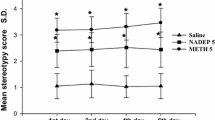Abstract
A comparison of the behavioral pharmacology of DOM and amphetamine in rats indicated that lower doses (0.10–1.0 mg/kg) of the two agents had similar effects on schedule-controlled food-reinforced and shock-avoidance behavior. Similarities were also noted in their effects on horizontally directed motor activity when testing was preceded by a period of acclimation. However, most doses of DOM tended to decrease unacclimated motor activity, while amphetamine increased this behavior.
Neuropharmacological antagonism studies indicated that brain catecholamines (CA) and serotonin (5-HT) are involved in the behavioral effects of both DOM and amphetamine. Cinanserin, a 5-HT receptor blocker, attenuated the behavioral disruptive effects of both agents on food-reinforced responding. Cinanserin attenuated the effects of all doses of DOM and those of higher doses of amphetamine on shock avoidance. When given prior to lower doses of amphetamine, there was a greater behavioral stimulation than when amphetamine was given alone. Prior depletion of brain CA with α-methyltyrosine (α-MT) did not affect DOM induced disruption of food-reinforced responding, while α-MT attenuated the behavioral effects of all doses of DOM and amphetamine on shock avoidance. These data suggest that DOM and amphetamine share a similar component in their mechanism of action which depends on the availability of a releasable pool of brain CA.
Similar content being viewed by others
References
Appel, J. B., Freedman, D. X.: Tolerance and cross-tolerance among psychotomimetic drugs. Psychopharmacologia (Berl.) 13, 267–274 (1968)
Appel, J. B., Lovell, R. A., Freedman, D. X.: Alterations in the behavioral effects of LSD by pretreatment of p-chlorophenylalanine and α-methyl p-tyrosine. Psychopharmacologia (Berl.) 18, 387–406 (1970)
Beaton, J. M., Smythies, J. R., Benington, F., Morin, R. D.: The behavioral effects of 2,5-dimethoxy-4-methyl-amphetamine (DOM) in rats. Commun. Behav. Biol. 3, 81–84 (1969)
Benington, F., Morin, R., Beaton, J., Smythies, J., Bradley, R.: Comparative effects of stereoisomers of hallucinogenic amphetamines. Nature New Biol. 242, 185–186 (1973)
Buxton, D. A.: Behavioral actions of some substituted amphetamines. In: Progress in brain research: Biochemical and pharmacological principles underlying behavior, P. B. Bradley and R. W. Brimblecombe, eds., pp. 171–180. Amsterdam: Elsevier 1972
Dyer, D. C., Gant, D. W.: Vasoconstriction produced by hallucinogens in isolated human and sheep umbilical vasculature. J. Pharmacol. exp. Ther. 184, 366–375 (1973)
Ferster, C. B., Skinner, B. F.: Schedules of Reinforcement. New York: Appelton-Century-Crofts 1957
Freedman, D. X., Gottlieb, R., Lovell, R.: Psychotomimetic drugs and brain 5-hydroxytryptamine metabolism. Biochem. Pharmacol. 19, 1181–1188 (1970)
Huang, J., Ho, B. T.: Differentiation of pressor and behavioral effects of d-amphetamine and 2,5-dimethoxy-4-methylamphetamine (STP) by cinanserin. Canad. J. Physiol. Pharmacol. 51, 976–980 (1973)
McMillan, D. E.: Drugs and punished responding. Rate-dependent effects under multiple schedules. J. exp. Anal. Behav. 19, 133–145 (1973)
Rech, R. H., Stolk, J. M.: Amphetamine-drug interactions that relate brain catecholamines to behavior. In: Amphetamines and related compounds, E. Costa and S. Garattini, eds., pp. 385–413. New York: Raven Press 1970
Sanger, D. J., Key, M., Blackman, D. E.: Differential effects of chlordiazepoxide and d-amphetamine on responding maintained by a DRL schedule of reinforcement. Psychopharmacologia (Berl.) 38, 159–171 (1974)
Scheel-Kruger, J., Hasselager, E.: Studies of various amphetamines, apomorphine and clonidine on body temperature and brain 5-hydroxytryptamine metabolism in rats. Psychopharmacologia (Berl.) 36, 189–202 (1974)
Schuster, C. R., Dockens, W. S., Woods, J. H.: Behavioral variables affecting the development of amphetamine tolerance. Psychopharmacologia (Berl.) 9, 170–182 (1966)
Shulgin, A. T., Sargent, T., Naranjo, C.: Structure-activity relationships of one-ring psychotomimetics. Nature (Lond.) 221, 537–541 (1969)
Smythies, J. R., Johnston, V. S., Bradley, R. J.: Behavioral models of psychosis. Brit. J. Psychiat. 115, 55–68 (1969)
Snyder, S. H., Faiłłace, L. A., Weingartner, H.: DOM (STP), a new hallucinogenic drug and DOET: Effects in normal subjects. Amer. J. Psychiat. 125, 357–364 (1968)
Sparber, S. B., Tilson, H. A.: Environmental influences upon drug-induced suppression of operant behavior. J. Pharmacol. exp. Ther. 179, 1–9 (1971)
Sparber, S. B., Tilson, H. A.: Tolerance and cross tolerance to mescaline and amphetamine as a function of central and peripheral administration. Psychopharmacologia (Berl.) 23, 220–230 (1972)
Swonger, A. K., Rech, R. H.: Serotonergic and cholinergic involvement in habituation of activity and spontaneous alternation of rats in a Y-maze. J. comp. physiol. Psychol. 81, 509–522 (1972)
Tilson, H. A., Rech, R. H.: Conditioned drug effects and absence of tolerance to d-amphetamine induced motor activity. Pharmacol. Biochem. Behav. 1, 149–153 (1973)
Tilson, H. A., Sparber, S. B.: Similarities and differences between mescaline, lysergic acid diethylamide-25 (LSD) and d-amphetamine on various components of fixed interval responding in the rat. J. Pharmacol. exp. Ther. 184, 376–384 (1973)
Tilson, H. A., Cavanagh, R. L., Baker, T. G., Gylys, J. A.: Neuropharmacological analysis of R(−)-2,5-dimethoxy-4-methylamphetamine (R-DOM). Pharmacologist 16, 205 (1974)
Tilson, H. A., Baker, T. G., Gylys, J. A.: A comparison of the discriminative stimulus properties of R-2,5-dimethoxy-4-methylamphetamine and S-amphetamine. Psychopharmacologia (Berl.) 44, 225–228 (1975)
Vrbanac, J. J., Tilson, H. A., Moore, K. E., Rech, R. H.: Comparison of 2,5-dimethoxy-4-methylamphetamine (DOM) and d-amphetamine for in vivo efflux of catecholamines from rat brain. Pharmacol. Biochem. Behav. 3, 57–64 (1975)
Winter, J. C.: Behavioral effects of N,N-diethyltryptamine: Absence of antagonism by xyłamidine tosylate. J. Pharmacol. exp. Ther. 169, 7–16 (1969)
Zimmerman, J., Schuster, C. R.: Spaced responding in multiple DRL schedules. J. exp. Anal. Behav. 5, 497–504 (1962)
Author information
Authors and Affiliations
Additional information
Supported in part by Grants NS-10323 from NINDS and MH-22093 from NIMH. Some of the data have been reported in abstract form elsewhere (Federation Proceedings 32, 818, 1973; The Pharmacologist 16, 205, 1974) and a portion of this work is from a thesis submitted to the Faculty of Michigan State University by W. J. M. in partial fulfillment of the requirements for the Ph. D. degree in Pharmacology.
Rights and permissions
About this article
Cite this article
Tilson, H.A., Baker, T.G., Chamberlain, J.H. et al. Behavioral and neuropharmacological analysis of amphetamine and 2,5-dimethoxy-4-methylamphetamine in rats. Psychopharmacologia 44, 229–239 (1975). https://doi.org/10.1007/BF00428899
Received:
Revised:
Issue Date:
DOI: https://doi.org/10.1007/BF00428899




